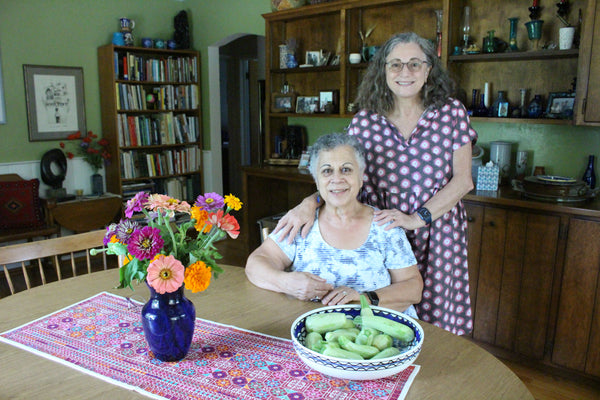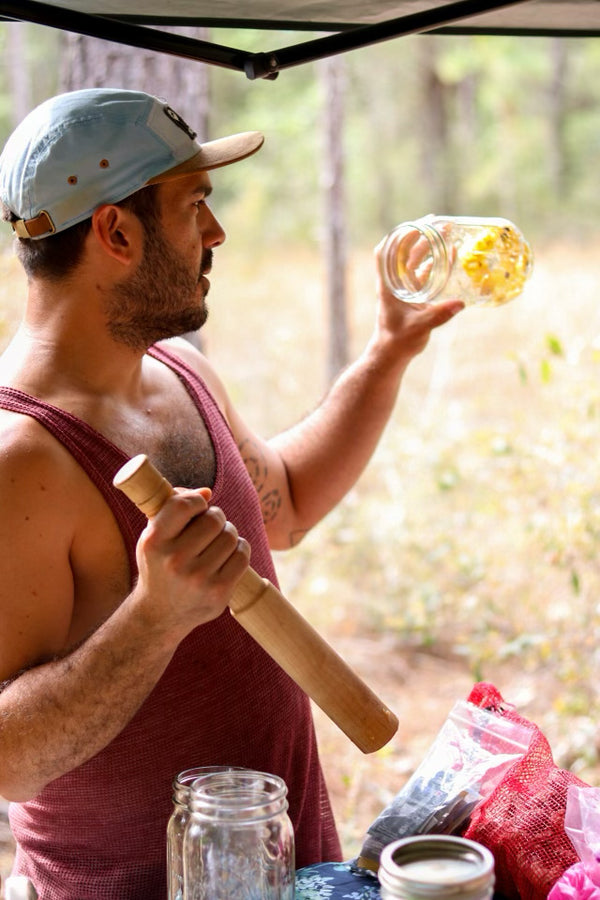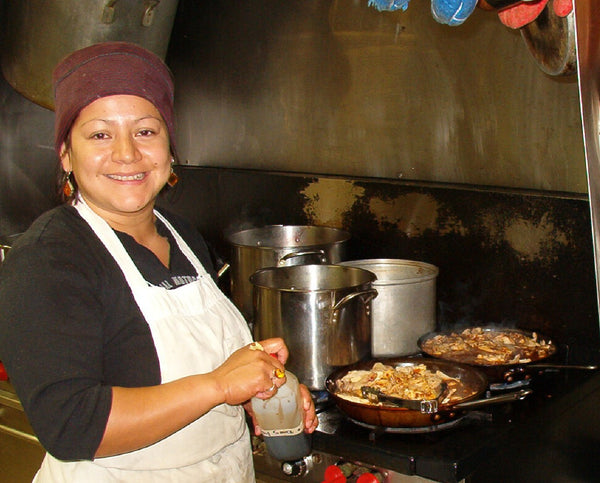From The Middle East and Eastern Europe all the way to Central America and islands in the Caribbean, our Seeds of Our Ancestors journey has taken us through a wide variety of ancestral food traditions. We hope that we have inspired wonder about the people whose stories we have shared, and also, curiosity about the remarkable and creative cuisines of these regions that have been cherished by families, passed down through generations, and are celebrated in the Midwest and elsewhere in the States.
This month, I interviewed former Nature & Nurture farm intern, Maya Faulstich-Hon. Hailing from a small town in Costa Rica, Maya’s mother is Chinese and her father, of European ancestry, is from the U.S. Growing up in a multicultural family has lent her a unique lens on ancestral foods. Her grandparents immigrated from China to Costa Rica during the Chinese Cultural Revolution, starting a small Chinese restaurant in San José to make ends meet during a difficult transition. The restaurant was a success, and a couple decades down the road was inherited by Maya’s parents. Maya grew up in a “restaurant family,” eating a variety of foods fused from different cultures and cuisines. When she turned 18, she left Costa Rica for the States to attend Brown University, taking her knowledge of all those foods with her to a new and unfamiliar place. A combination of her roots and her love for the environment, especially as it intersects with farming and local food systems, has allowed her to take a bit of home wherever she goes.
Within the Faulstich-Hon ancestral line, from Maya’s grandparents to her parents to herself, there runs a spirit of experimentalism, play, and curiosity, winning out over strict family recipes and a specific assortment of foods. Their ancestral seed, in this case, was more a seed of nonconformity, of problem-solving, and of experimentation.
From China to Costa Rica
Maya grew up in Escazú, a small town in the foothills of some of the mountain ranges that encircle the Central Valley in San José, Costa Rica. Her parents are the proud owners of Tin Jo (which means “the best” in Mandarin), a successful restaurant serving a variety of Pan-Asian cuisine in the heart of San José. They inherited the business from Maya’s grandparents, who immigrated from China to Costa Rica in 1970 during the Cultural Revolution in China. Maya’s grandparents, along with other Chinese citizens, moved elsewhere in the world at that time, seeking asylum from the terrors occurring in their homeland, hoping for a better future.
Maya’s grandparents, Chi Wha (José) Hon and Miu Kan (Rosa) Cheng, ended up in Costa Rica “with 4 daughters, 2 engineering titles, not much money, no Spanish and a dream for a better future,” according to María Hon, Maya’s mother. They weren’t able to use their engineering degrees because of their immigrant status, and so they made the entrepreneurial decision to open a Chinese restaurant. Maya’s grandfather had a brother who had immigrated to Costa Rica before them and had successfully started his own restaurant, and so he showed his brother the ropes and helped him and his wife create a restaurant they could be proud of.
When José and Rosa first started the restaurant, they lived in the flat above it with their four daughters, and worked hard to ensure its success. María, age 12 when they first arrived in Costa Rica, helped take care of her younger sisters, in addition to helping out in the kitchen; she peeled, chopped, grated, cleaned, and did whatever was needed to support her parents. After getting a degree in chemical engineering and an MBA in the States, and meeting her husband, Robert, along the way, María returned in 1994 with Robert to take over her parents’ restaurant. Together, they added Thai, Indian, Indonesian, Japanese, and Korean cuisines to their menu, in addition to serving Chinese food. Robert and María raised their two daughters, Maya and her sister, Leila, in Costa Rica, as they continued to serve delicious food to both the public and to their family.
Spending time in the kitchen cooking with her mom is still one of Maya’s favorite things to do when she visits home. Maya says that her mom talked endlessly about food and about the restaurant when she was growing up, and that “that hasn’t changed one bit.” Maya’s biggest takeaway from her family's food traditions, though, is the willingness and curiosity to experiment in the kitchen, and to take risks, because you never know when they might turn out to be particularly delicious ones…

Pictured: Maya and her mama, enjoying a picnic meal together outside. (Photo credit: María Hon)
Food Fusion
The foods Maya holds closest to her heart are comfort foods; foods that will heal you when you are sick, feeling unwell, or just generally in need of a boost in spirit. But even her family’s comfort foods involve a spirit of experimentation and intrigue.
“Our family’s sick food is rice congee, or ‘Zouk’ in Mandarin,” says Maya. Zouk is a traditional Chinese rice porridge known for its healing properties. “You just boil rice for a really long time, past the point you would normally cook it, and then you just add whatever you want to it. My mom would usually add ginger slices, scallions, and soy sauce,” Maya tells me. The Faulstich-Hons’ idea of rice congee is a very simple dish that can be twisted slightly to create any number of new variations. Maya’s grandmother, for example, will add things like dried scallops, dried anchovies, and sometimes goji berries and other nuts and seeds to add more complex flavors.
Another food that speaks of home for Maya is her grandmother’s famous Strange Soup. “Every family dinner she’ll make Strange Soup, and she shares it with my mom all the time. The name is something specific to our family, but many of the ingredients are Asian-inspired,” Maya says. Maya doesn’t even know all the ingredients, because in addition to many of them coming from miscellaneous plastic packets with Chinese characters on them, the recipe isn’t always the same. “Who even knows what these things are,” laughs Maya, “Dried herbs of all sorts, dried fish sometimes, dried fruits… some of the ingredients I do know she uses are Angelica root, lotus root, ginkgo nuts, goji berries, dried scallops sometimes, dried lotus flowers… all these little odds and ends of stuff, but it’s like, super healthy, really good for your energy, and it’ll cure you of whatever ailment you have.”

Pictured: Some of the ingredients in Doña Rosa's Strange Soup. Can you guess what they are? (Photo credit: María Hon)
Growing up, another food Maya remembers with fondness is sushi - but not your typical, traditional sushi. “Another thing we did growing up was completely butcher authentic versions of things. We’d have ‘sushi nights,’ where my mom would get this huge piece of nori and cut it into quarters. We’d have a ton of random ingredients out so that you could put whatever you wanted in it and roll it up into your nori. We’d have your typical cucumber, carrots, and surimi, but also mango slices, leftover stir-fry - really whatever was in the fridge. My sister went through a phase where she put raisins on everything and I have no doubt there were some raisin-y sushi rolls at times.”
Of course, Maya’s family had the whole gamut of fresh fruits and veggies of Costa Rica at their fingertips, as well, and weren’t afraid to experiment with local food. They would always have lots of ripe plantains available in the kitchen, and would “slice them down the middle, add whatever filling you want, and stick ‘em in the oven.” Savory fillings would include cheese or yogurt, while a dessert-style plantain would be stuffed with chocolate, cinnamon, and other sweet treats. “My Dad is a total fiend when it comes to chips, and so we’d have a bag of green plantain chips lying around the house at all times.” Maya’s mom would always be experimenting with new veggies. Whatever was in season, she would mix and match it with other ingredients to create delicious new salads. Maya recalls catching her mother putting soy sauce and wasabi on her fruit salad one day. She remembers expressing her disgust while her mother held it out to her and urged her to “just try it!” Maya’s sister has also followed in her mother’s footsteps over the years, playing with mixing different ingredients in unusual ways. She’s known to make a variety of interesting desserts featuring ingredients like black sticky rice, tahini, and moras (local blackberries), for example.

Pictured: Maya post-harvest with some yummy greens. (Photo credit: Maya Faulstich-Hon)
The only tradition in the Faulstich-Hon household seems to be breaking it; they are always seeing new possibilities, new fusions, new creations, and with such a diverse knowledge of cuisines and ingredients at their fingertips, the kitchen and their restaurant becomes a place for play and exploration.
The Thrifty Seed Saver
Everything about food has always played a huge role in Maya’s life - from growing it, to cooking, eating, and sharing it, all the way to how it can impact communities and larger systems in the world. “Food has definitely always been an important part of my life. It brought me to Nature & Nurture farm and a lot of other farms and food-related jobs,” reflects Maya. “I’ve always loved being in the soil and growing food, and cooking and sharing it with people, so it’s not just one of my hobbies and passions, but also a fundamental way I show and receive love.”
Even now, Maya is practicing seed saving and gardening in Vermont, where she currently resides, working remotely for a company that applies behavioral science to a variety of social problems. She attends seed swaps, trades seeds with friends, and even goes “seed foraging.” “I literally once grabbed a bunch of calendula from the side of the road and saved the seeds from it,” she recalls, laughing. Bok choy was always featured heavily in meals growing up, and Maya makes sure to always have some planted in her garden. “It’s so easy to grow, and you can harvest it at any stage and it tastes good!”

Pictured: Maya and her tomatoes! (Photo credit: Maya Faulstich-Hon)
Maya doesn’t know what the future holds for her, but she says that you can count on her staying in Vermont at least until the end of the summer, so that she can harvest her bounty of fresh produce at the end of it.
A Night with Doña Rosa
A couple years ago, Maya returned home to spend time with her family in Costa Rica during the pandemic. While she was there, she asked her grandma, Doña Rosa, who she calls Popo, if she could teach Maya how to make some of her famous dishes. Specifically, Maya remembers that as a kid, whenever there was a big occasion, like Chinese New Year or family birthday dinners, Popo would cook 7-9 separate dishes, and would lay them all out on huge plates in the middle of the table. Her grandma was excited about Maya’s request; “Yeah yeah! Come over tomorrow. We’ll tell the family to come later for dinner and we’ll work together earlier to prepare it.”
“When I got there,” Maya smiles, “everything was basically already prepared! The very last step of each dish was left and Popo said, ‘Ok, and this is how I season it at the end. Once you have everything ready, just put these condiments on top!’ She said ‘I already got everything chopped, that’s boring, you don’t need to do that.’ So how much I really learned that night was questionable, but I did make her go through some of the steps with me so that I could write them down.”
“My biggest takeaways from that evening were, for one, I didn’t realize how much she experiments. I had this idea in my mind that these were all these really traditional Chinese dishes that her mom taught her, but no, she made all this stuff up!” Maya throws her hands up in feigned exasperation. She tells me that when a few of their family members, including herself, went vegetarian, her grandma learned to cook a delicious variety of tofu dishes. She experimented and adapted to her family’s needs. “These days, she hardly cooks with meat at all,” Maya says.
Maya’s second takeaway was that her grandma tends to use a few foundational ingredients - soy sauce, vodka, sesame oil, and apple cider vinegar. She then mixes and matches them in a wide variety of dishes with different veggies, herbs & spices, proteins, grains, and consistencies, so that every session in the kitchen is full of experimentation, fusion, and creativity.
“It’s fun to see my grandma these days. She’s almost 90 now, and she’s the exact opposite of ‘getting stuck in her ways.’ She’s constantly learning new things. A few years ago, she discovered avocado oil, and now she, like, only cooks with avocado oil - she buys it in bulk from PriceSmart [the Costco of Costa Rica], and always has 10-15 giant bottles of avocado oil in her pantry, ready to go. She started learning the piano during COVID, and she takes painting classes, travels… that experimental, curiosity, and willingness to learn that are part of her philosophy of food extend to all parts of her life.”
As we wrap up our interview, Maya tells me that she didn’t fully realize the gene of experimentalism that seems to run through her family until we chatted about it that day. Though many ancestral foods remain important to Maya and her family, both from Chinese and Costa Rican traditions, even more important it seems is the ability to create new dishes, to play, to explore. “I feel like there’s this parallel there, having grown up in such an amalgamation of cultures. I personally don’t feel quite like I’m Chinese, Costan Rican, or American - I’m one big experiment!” exclaims Maya.
I wonder what might happen if we all saw our kitchens and our lives not just as places to learn about our past, but as vehicles for experimentation, fusion, creativity, to find out what the future may hold for us, as well.

Pictured: Maya harvesting tomatoes at Nature & Nurture Seeds, 2018.




